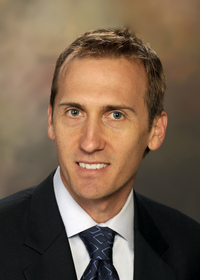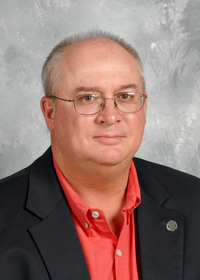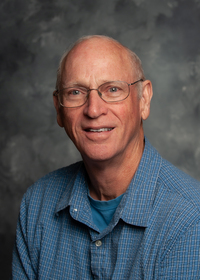Lespedeza Control in Maintained Turfgrass
Common lespedeza (Kummerowia striata, sometimes referred to as Lespedeza striata) and Korean clover (Kummerowia stipulacea) are troublesome turfgrass weeds throughout most of the southeastern United States. Both are warm-season, annual legumes that emerge as seedlings in late spring and early summer (March through June) in Mississippi.
Common lespedeza and Korean clover have trifoliate leaves (oblong leaflets of three) originating from an often brownish-red, woody stem clasped by stipules at the base of each leaf stalk. Common lespedeza is capable of withstanding very low mowing heights (less than 1 inch), yet it may rise to more than a foot in height if left unmown. The taller Korean clover is less prevalent within maintained turfgrass due to lower mowing heights. Both are present in scenarios with higher mowing heights, such as roadsides and golf course roughs.
Common lespedeza and Korean clover are similar in distribution and appearance; however, they can be distinguished by close examination of differences in growth habit. Korean clover is often taller, produces coarser foliage with broader leaflets, and has upward-pointing stem hairs. Common lespedeza has downward-pointing stem hairs. Other lespedezas in the southeast are perennial in nature but otherwise share common traits.
Common lespedeza and Korean clover produce shallow taproot systems, enabling them to tolerate dry and/or compacted soils. Like other legumes, such as white clover, lespedeza and Korean clover form symbiotic relationships with soil-borne bacteria to produce root nodules where atmospheric nitrogen is fixed and incorporated into the plant as proteins. Nitrogen is subsequently shared with associated grasses through the decomposition of roots and foliage. For this reason, legumes are sometimes considered beneficial additions to low-maintenance turfgrass. The presence of lespedeza and clovers is considered by some to be an indicator that nitrogen is limited for turf growth.
Cultural Prevention
Common lespedeza is a weed in all types of turfgrasses, but it is especially prevalent in poor soils or in turfs that receive limited supplemental nitrogen. Legume persistence is partly due to an ability to biologically fix atmospheric nitrogen. With the exception of centipedegrass lawns, supplemental nitrogen is necessary to allow turfgrass to compete with the nitrogen-fixing legume. Follow nitrogen fertilization recommendations found in MSU Extension Publication 1322 Establish and Manage Your Home Lawn.
Alleviating soil compaction is also key to controlling common lespedeza. Reducing foot and mower traffic may allow increased turfgrass competitiveness with this and many other weeds. In some instances, aerification may be required to reduce soil compaction. To optimize the effort and expense of aerification, cores should be removed and composted rather than returned into holes. Ideally, sand, organic matter, or compost should be top-dressed into holes in order to reduce soil density and increase soil moisture and nutrient-holding capacity.
Infrequent and deep irrigation can be applied in drought situations to alleviate turf stress in problem areas.
Avoid spreading seed and plant material by thoroughly washing mowers and other equipment after use in weed-infested areas.
Chemical Control
Preemergence herbicides (those applied before seedlings emerge), including atrazine (AAtrex, Bonus S with atrazine, and others), dithiopyr (Dimension and others), pendimethalin (Pendulum and others), prodiamine (Barricade), and simazine (Princep and others) provide varying degrees of lespedeza control, depending upon application rates and timing. Preemergence applications in mid- to late spring provide more control than applications made in late winter.
Postemergence control (herbicides applied after seedlings emerge) also depends upon adequate application timing. Lespedeza and Korean clover plants become “hardened-off” and difficult to control as summer progresses. Their woody stems and drought avoidance capabilities mean early detection and treatment is required to control them successfully. Scouting for lespedeza should begin in spring (roughly March on the coast and April in north Mississippi).
Multiple applications of premixed liquid products containing auxin-like herbicides, such as 2,4-D, MCPA, mecoprop, and dicamba (Trimec, Weed B Gon, etc.), are effective if applied early. For homeowners, these “broadleaf”-specific herbicides are typically available at local lawn and garden stores.
Metsulfuron-containing compounds (Topshot, MSM Turf, Manor, Blindside) provide good to excellent control of common lespedeza. Early applications of atrazine-containing compounds (Bonus S with atrazine, AAtrex, and others) may also provide acceptable control of common lespedeza.
Commercial applicators may find that the pyridine herbicides (fluroxypyr, triclopyr, clopyralid, etc.) are more effective in late-season applications than the other auxin-like herbicides mentioned previously. Escalade 2 (2,4-D, fluroxypyr, and dicamba) and similar products that contain a pyridine herbicide with dicamba provide good to excellent control. However, many are not labeled for sensitive turfgrasses, such as centipedegrass and St. Augustinegrass.
Care should be taken to properly calibrate application equipment and apply herbicides accurately to prevent turf and landscape injury. Read product labels carefully and completely, as not all herbicides can be applied to warm-season turf species. More information on controlling weeds in turfgrass can be found in MSU Extension Publication 1322 Establish and Manage Your Home Lawn.
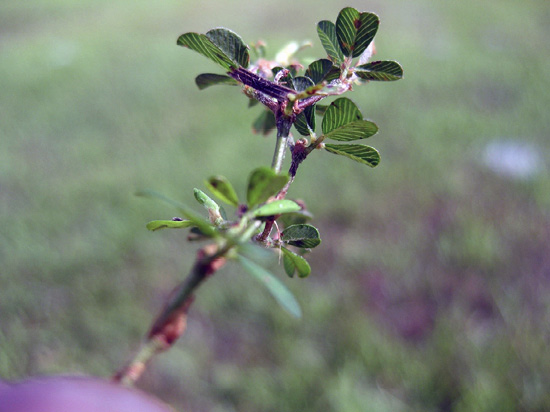
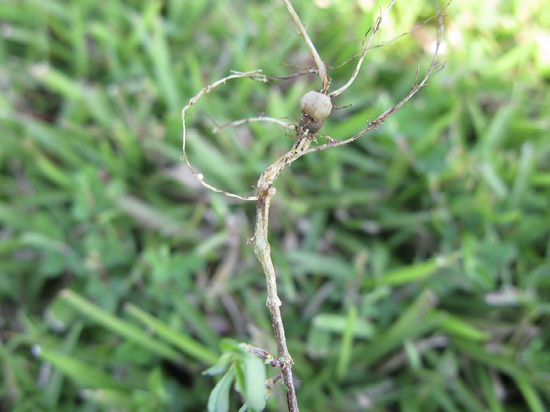

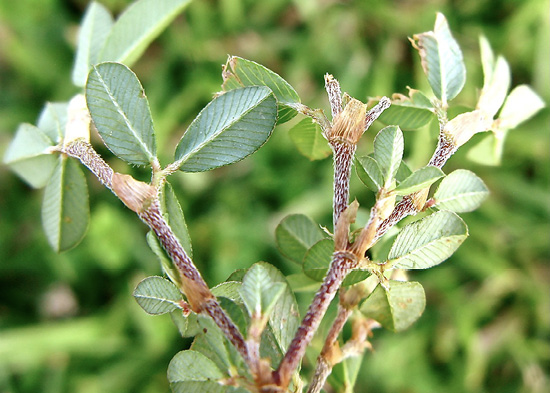

|
Turf species tolerance |
||||||
|---|---|---|---|---|---|---|
|
Herbicide |
Bermuda |
Centipede |
St. Augustine |
Zoysia |
Tall Fescue |
Common lespedeza and Korean clover control |
|
2,4-D |
Yes |
Yes |
Yes |
Yes |
Yes |
Poor |
|
atrazine (Bonus S, AAtrex) |
Yes |
Yes |
Yes |
No |
Good |
|
|
Avenue South |
Yes |
Yes |
Yes |
Yes |
Yes |
Good |
|
Blindside |
Yes |
Yes |
Yes |
Yes |
Yes |
Excellent |
|
Celsius |
Yes |
Yes |
Yes |
Yes |
No |
Good |
|
Change-up |
Yes |
Yes |
Yes |
Yes |
Yes |
Excellent |
|
dicamba |
Yes |
Yes |
No |
Yes |
Yes |
Fair |
|
Escalade 2 |
Yes |
No |
No |
Yes |
Yes |
Excellent |
|
metsulfuron-methyl (Topshot, MSM-Turf or Manor) |
Yes |
Yes |
Yes |
Yes |
No |
Excellent |
|
Speedzone Southern |
Yes |
Yes |
Yes |
Yes |
Yes |
Fair |
|
Turflon Ester (triclopyr) |
Yes |
Good |
||||
|
Confront (triclopyr + clopyralid) |
Yes |
Yes (but not on sod) |
No |
Yes |
Yes |
Excellent |
|
Trimec Southern |
Yes |
Yes |
Yes |
Yes |
Yes |
Fair |
|
Vista XRT |
Yes |
Yes |
Yes |
Yes |
Yes |
Excellent |
The information given here is for educational purposes only. References to commercial products, trade names, or suppliers are made with the understanding that no endorsement is implied and that no discrimination against other products or suppliers is intended.
Publication 2910 (POD-02-22)
By Jay McCurdy, PhD, Associate Professor, Plant and Soil Sciences.
The Mississippi State University Extension Service is working to ensure all web content is accessible to all users. If you need assistance accessing any of our content, please email the webteam or call 662-325-2262.


